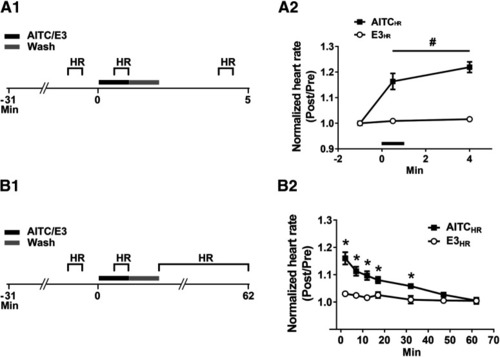
Heart rate in larval zebrafish is persistently increased by AITC. A1, Experimental protocol for examining the effect of AITC/E3 on heart rate. The experiments were performed on larvae fully restrained in agar. Heart rate was measured by visual inspection during 30-s periods that began at: 1 min before the onset of treatment (for 1 min) with AITC/E3; 30 s after the onset of AITC/E3 treatment; and 2 min after the end of the 1-min washout period. A2, Effect of AITC/E3 on larval heart rate. A repeated-measures, two-way ANOVA revealed a significant overall effect of AITC exposure (F(1,14) = 78.68, p < 0.001). The AITC-exposed fish (AITCHR group, n = 8) showed an increase in normalized heart rate in the presence of the chemical irritant as well as at 2 min after washout compared with fish (E3HR group, n = 8) exposed only to E3. B1, Experimental protocol to determine the persistence of the increase in heart rate caused by AITC. B2, Postexposure effect of AITC on heart rate. A repeated-measures, two-way ANOVA (F(6,84) = 14.44; p = 0.001) found an interaction between exposure to AITC/E3 and the time of test. Probes of this interaction using one-way ANOVAs indicated that the differences between the AITC-treated (n = 8) and the E3-treated (n = 8) groups were significant (p < 0.05) on the tests from immediately after washout of AITC/E3 up to and including the 32-min test. This figure shows means ± SEM, with * indicating a significant (p < 0.05) difference between groups and # indicating a significant (p < 0.05) main effect.
|

